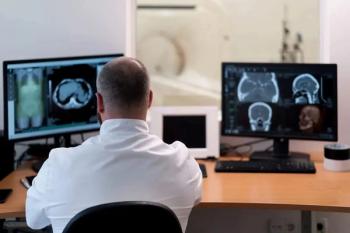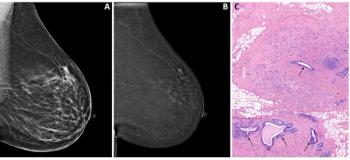
New breed of CT creates MR-like soft-tissue images
CT scanners have evolved to the point where the number of slices per rotation may no longer be the benchmark for performance. Siemens and GE have created wholly new platforms, both markedly different and remarkably alike, that deliver images with detail so rich they look more like MR than CT.
CT scanners have evolved to the point where the number of slices per rotation may no longer be the benchmark for performance. Siemens and GE have created wholly new platforms, both markedly different and remarkably alike, that deliver images with detail so rich they look more like MR than CT.
The two new products, Siemens' Definition AS (adaptive scanning) and GE's tentatively dubbed HD (high definition) CT, were unveiled at the RSNA meeting.
Definition AS delivers spatial resolution of 0.24-mm pixels thanks to two underlying technologies: Siemens' z-Sharp, which doubles the slice number per rotation, and its Straton x-ray tube and the concentrated focal spots it makes possible. Siemens' new CT boasts 300-msec rotations, faster temporal resolution than the current industry benchmark of 330 msec.
"That 10% window allows more measurements in a set time, helping to resolve complex clinical structures," said Peter Kingma, Siemens vice president for CT.
An example is the coronary artery, which typically moves in several planes as the heart beats. If this artery is burdened by calcium, its movements can create a blooming artifact or shadow inside the artery that can be mistaken for soft plaque buildup, Kingma said.
"That is a condition the physician wants to be very certain about, if it is there," he said. "The Definition AS can provide that certainty."
Heightened spatial and temporal resolution vastly improve the potential for stroke assessment and characterization of cancerous tissue, according to Kingma. The risk presented by aneurysms can be better assessed through vascular kinematics demonstrated using blood flow analysis now possible with the Definition AS.
Workflow is aided by a 30-mega heat unit x-ray tube that allows the system to run at high power levels for as many patients as needed without downtime for cooling, Kingma said. This could prove important inside and outside the diagnostic realm.
"We see CT as an interventional tool with potential far beyond what is currently in use in CT fluoroscopy," he said. "We see the potential to design a scanner that has a dedicated processor that can do complex interventional procedures in 3D, tracking a needle as it enters the patient and moves toward the lesion far more accurately and safely than is now being done."
Definition AS is "adaptive" because of its versatility, which can be seen during assembly, as the scanner, currently a work-in-progress but slated to begin shipping in May, can be configured with 20, 32, or 64 detector rows.
It bears the class name of Siemens' dual-beam scanner unveiled two years ago but depends on a single x-ray beam. Definition AS incorporates many of the other advanced technologies found in the dual-beam system platform, however, including an advanced data acquisition system that handles the flood of information.
"This is a totally different system that has the DNA of the best-of-breed innovations we have brought out over the last 10 years," Kingma said. "But it is an absolutely new platform."
With its new HDCT, a work-in-progress in both technology and name, GE Healthcare has enhanced every component in its CT imaging chain, redesigning the x-ray tube to shape the focal spot to suit the target of head, chest, abdomen, and legs; boosting the data acquisition system to optimize information handling; and enhancing reconstruction software and hardware. GE swapped its decades-old detector material for one 98% composed of garnet. The new material responds 150 times faster to the light created by x-ray strikes on the detector and cuts afterglow to one-tenth the previous time, substantially reducing signal noise.
"This cuts out a lot of the artifacts found in traditional CT imaging," said Dominic P. Smith, general manager of molecular imaging, CT marketing and advanced applications. "Beam hardening goes away."
Resolution goes from 14 line pairs per centimeter on the LightSpeed VCT to 18 lp/cm with HDCT. The clinical result is CT detail never before seen, as with soft tissue in the bowel, bladder, and prostate; liver vasculature and muscle stratification; brain aneurysms and even the fine mesh of stents implanted to stabilize aneurysms.
"The old way of CT was to produce the same image quality but with more slices," said Brian Duchinsky, general manager of global CT at GE Healthcare. "What we've done is to change the image clarity to see a whole new type of image."
GE's new CT platform, expected to begin shipping in mid-2008, also features Volume Shuttle, which synchronizes the patient table and detector to widen the area of coverage, covering blood perfusion of the brain, heart and lungs, or liver. Moving the patient back and forth and gating the data acquisitions can dynamically capture a swath 25 cm wide.
Similar to GE's shuttle is Siemens' Adaptive 4D Spiral, which uses synchronized table movements to cover up to 27 cm. The computer-controlled exam automatically and constantly varies the pitch of the table, "so the patient is almost unaware of the changes in direction," Kingma said.
Siemens has built a 100-kW generator into the Definition AS capable of producing high-quality dynamic images even on bariatric patients lying on the company's new 650-pound-capacity table through its 78-cm wide-bore gantry.
"Combine the demands of bariatric and cardiac imaging in one examination, and you can see the added power is advantageous to the clinician," Kingma said.
The faster gantry rotation, as well as a new dose reduction technique employing an "intelligent" collimator, keep patient dose in check by blocking radiation coming from the first and last 180 degrees of rotation during the exam. These two half-rotations provide no diagnostically useful data, he said.
Attesting to the importance vendors attach to dose reduction, GE has developed a suite of reconstruction techniques of its own to produce dose reductions. They are catalysts for the adoption of technology that GE executives describe as being as fundamentally different as multislice CT was.
Siemens executives are just as pumped about their Definition AS, viewing the platform as the means for transcending the industry's slice wars.
With the introduction of these products in mid-2008, Siemens and GE hope to shift the comparison of CT scanners from slice numbers to image quality, a shift both companies agree is in line with radiology's long and abiding interest in this criterion.
Newsletter
Stay at the forefront of radiology with the Diagnostic Imaging newsletter, delivering the latest news, clinical insights, and imaging advancements for today’s radiologists.






























